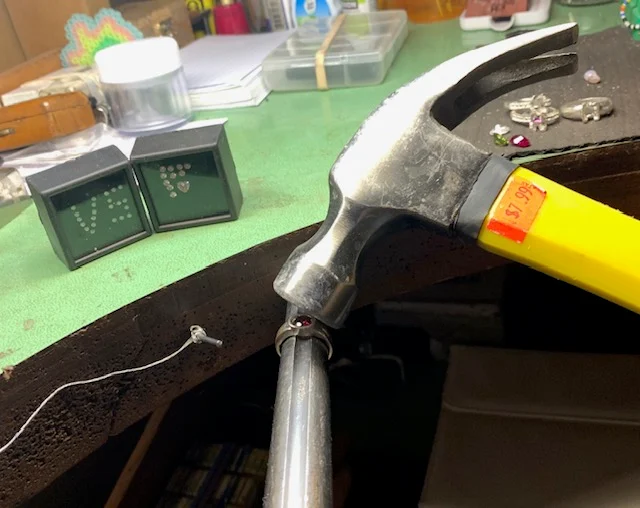This photo shows the "Reciprocating Hammering" process being displayed.
This Ruby stone has yet to be hammered, but it is correctly placed into the bezel.

In a full review of the Ruby (Red Stone) setting there are many details that MUST be followed and carefully adhered to. The very first is to make sure that the stone is sitting flush with the bezel.
In this photograph, you (and I) can see that the stone in conjunction with the bezel, is slightly 'crooked'.
The Culet of the stone appears to be protruding from underneath the ring. Therefore it is incumbent on me (the setter) to place this Culet in the recess in the mandrel.
You can easily see the 'slanted-crooked' oval stone. Once the stone is set, there is no way the stone to be altered.
I enjoy using this "Inside, ring clamp". Instead of gripping the sides of the ring, the inner clamping plastic literally expands and locks the ring TIGHT.
In using the rectangular-shaped "Reciprocating Hammer Anvil" I purposely used the narrow edge. The reasoning is that all of the hitting power is going to a small spot.
With your Onglette #2 graver which is polished and made smooth with "Polishing Paper" of #800grit, Bright-Cut the inside of the Bezel.
In keeping with a smooth angled surface, it is advisable to use your Pumice Wheel of #180 grit.
Once the #180 grit wheel has been finished, then and only then should you use the #1,000 grit (PINK) Pumice wheel. This process overrides the need of using cloth-polishing wheels.
In my vast array of 'finishing wheels' here is my finished ring.
I prefer to stabilize my ring in my fingers and against my bench peg. (Sorry for the blurred photo.)
I use a "Medium grit, Emery "Snap-on" disk to remove any defects from the casting process.
In this diagram is the sequence, or a guide, in the hammering process.
If properly followed, no Oval stone will ever get set 'twisted. The numbers 1-6 in this diagram are an absolutely accurate method in having any oval stone set perfectly. THERE ARE NO SHORT-CUTS in this 'sequence of hammering'.
After spending 65 YEARS of gemstone setting, I do know a few techniques to help you.



.jpg)


.jpg)


.jpg)
.jpg)

















.jpg)


.jpg)
.jpg)












.jpg)
.jpg)
